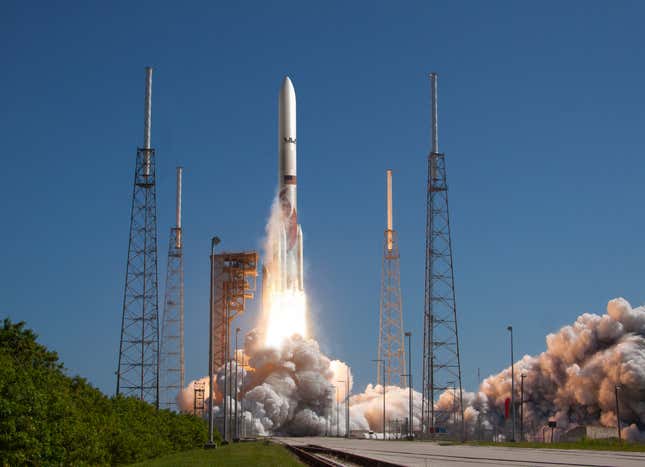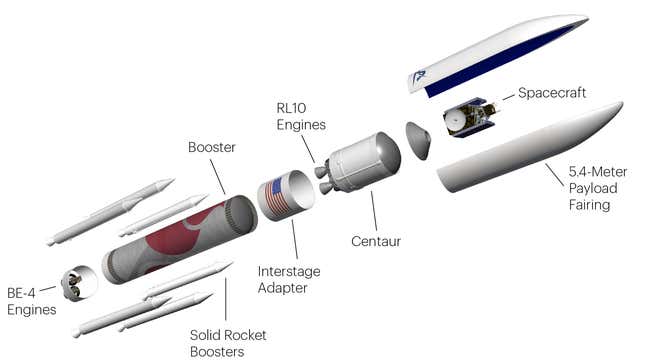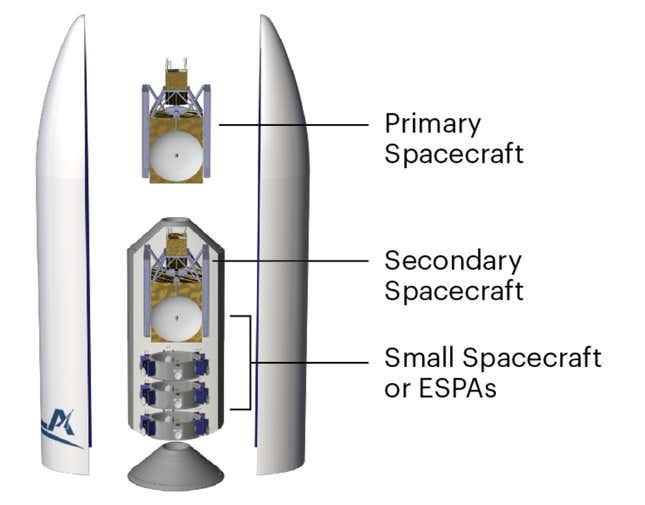ULA’s Vulcan Centaur Rocket Set to Launch Monday, a Challenge to SpaceX
On Monday, January 8, United Launch Alliance’s Vulcan Centaur could finally perform its first flight. ULA has been a rock in the spaceflight industry since its founding in 2006, and with this pending launch, the company is ready to take its next bold step into space. Here’s what you should know about America’s latest powerhouse rocket and and how it could disrupt the sector and compete with the ever-dominant SpaceX.
The 202-foot-tall (61.6-meter) Vulcan Centaur rocket is set to launch from Space Launch Complex-41 at Cape Canaveral. This is a huge deal, as it marks the debut of ULA’s first new rocket design in 18 years. While the (mostly) expendable Vulcan Centaur may not be revolutionary from a technological perspective, it represents a significant evolutionary step for ULA, a joint venture of Lockheed Martin Corporation and The Boeing Company.
The Vulcan Centaur rocket is vital for U.S. national security and commercial space interests, whether it be for deploying critical reconnaissance satellites or launching innovative spaceplanes. It’s designed to meet the requirements of the U.S. Space Force and intelligence agencies for national security satellite launches. But it’ll also serve as a launch vehicle for private space ventures, including 38 launches to deploy satellites for Amazon’s Project Kuiper.
Vulcan Centaur’s developmental journey was significantly influenced by both geopolitical events and competitive pressures in the aerospace industry. The annexation of Crimea by Russia in 2014 was a pivotal moment, compelling ULA to reassess its reliance on Russian RD-180 engines. This situation, coupled with growing competition from SpaceX, spurred ULA’s decision to collaborate with Blue Origin in developing the BE-4 engines, signifying a tactical shift toward greater national self-reliance in rocket engine technology.
Vulcan integrates design elements from both ULA’s Atlas V and Delta IV rockets and is poised to be their successor. It can deliver payloads to a wide range of target destinations, from low Earth orbit (LEO) and geosynchronous orbit (GEO) through to lunar and deep space exploration missions. It’s a highly versatile rocket, equipped with the capability to launch multiple payloads simultaneously.
Available in four standard configurations, Vulcan Centaur’s payload capacity varies based on the number of solid rocket boosters used, either zero, two, four, or six SRBs. Its maximum capability allows it to carry up to 25.8 metric tons to LEO and 7 metric tons to GEO. In comparison, SpaceX’s Falcon Heavy can lift more to LEO and GEO, but Vulcan Centaur’s flexibility and mission adaptability sets it apart.
The Vulcan Centaur’s first stage is equipped with two BE-4 engines, each producing 550,000 pounds of thrust, using a combination of liquified natural gas and liquid oxygen as propellants. Liquefied natural gas, primarily composed of methane, was chosen for its efficiency and potential reusability (ULA eventually aims to salvage and reuse the BE-4 engines from Vulcan launches, but not the first stage itself). The second stage is powered by two RL10 engines from Aerojet Rocketdyne—efficient engines with a long history of reliability. The rocket’s payload fairings, designed to accommodate a wide range of missions, can reach up to 70 feet (21.3 meters) in length and 17.7 feet (5.4 meters) in diameter.

Vulcan Centaur could make serious waves in the spaceflight industry, with ULA potentially matching SpaceX’s lower launch prices, according to the Motley Fool. SpaceX, known for revolutionizing space travel with affordable launches like the $67 million Falcon 9, prompted ULA to respond with a more affordable option. Vulcan, set to launch at under $100 million, marks a substantial cost reduction from the company’s $400 million Delta IV Heavy. This strategic pricing means ULA can stay somewhat competitive, demonstrated by its shared $2.5 billion Space Force contract with SpaceX, and even without the benefit of reusable rockets.
While this might mean lower revenues for Boeing and Lockheed Martin, the Vulcan Centaur’s cost-effectiveness could prove beneficial in the long term. This development signals—hopefully—a tightening competition in the space launch sector. What’s more, customers must weigh other considerations beyond just launch costs, such as fairing adaptability and the increasing issue of backlogs. Needless to say, the introduction of SpaceX’s Starship megarocket could complicate the landscape for ULA, but only time will tell.
Vulcan will serve as a major workhorse for the Pentagon, lifting critical national security payloads into orbit and playing a pivotal role in U.S. defense strategy. Accordingly, Vulcan is poised to capture (and has already captured) a significant share of U.S. military contracts, challenging SpaceX’s recent uptick in this sector.
Indeed, SpaceX’s entry into the military sector has posed a significant concern to ULA, which previously enjoyed an almost exclusive control over military launches for the Pentagon. With the introduction of Vulcan, ULA stands a chance to regain a portion of this market. However, considering SpaceX’s rapid rocket recycling capabilities and its upcoming Starship megarocket, it’s unlikely that ULA will fully return to its glory days.
Related article: NASA-Funded Space Ventures Set for Back-to-Back Moon Landings in Early 2024
Throughout its history, ULA has successfully completed over 155 space missions with its Atlas V and Delta IV rockets, serving both government and commercial partners. NASA has traditionally been a key client, with ULA rockets launching the space agency’s Curiosity and Perseverance Mars rovers, the New Horizons mission to Pluto, and the OSIRIS-REx asteroid sampling mission. SpaceX and other competitors are steadily encroaching onto this territory, but Vulcan Centaur could keep ULA competitive.
Right from the outset with Vulcan Centaur, ULA is collaborating with a NASA-funded endeavor. The rocket’s initial mission involves transporting Astrobotic’s Peregrine lander to the Moon under the space agency’s Commercial Lunar Payload Services program. The box-shaped lander is slated to land near Sinus Viscositatis, where it will deliver an array of payloads for NASA and other paying customers. Additionally, this launch represents the first of two scheduled missions required for obtaining certification from the U.S. military (hence the mission’s name, Cert-1). A second certification mission is planned for this coming April.
It hasn’t been a smooth path to the starting line. In development since 2014 and originally slated for launch in 2019, Vulcan Centaur has faced its share of challenges, including engine delivery delays from Blue Origin, delays stemming from the covid-19 pandemic, and a testing explosion in March 2023. Despite these hurdles, the rocket completed key tests, including a successful hot fire test in June 2023 and a wet dress rehearsal last month, setting the stage for its upcoming maiden voyage.

Interestingly, ULA could be sold later this year, with Blue Origin being a potential bidder. “If I were buying a space business, I’d go look at ULA,” CEO Tory Bruno told Bloomberg in October. “It’s already had all the hard work done through the transformation. You’re not buying a Victorian with bad plumbing. It’s all been done. You’re coming in at the end of the remodel, so you can focus on your future.” At a November media roundtable, Bruno claimed that Vulcan rockets have a backlog of over 70 future launches worth billions, with an aim to launch two Vulcans per month by the end of 2025.
As noted, Vulcan Centaur’s mission docket extends beyond the upcoming lunar mission. It includes launching Sierra Space’s Dream Chaser spaceplane, multiple classified missions for the U.S. Space Force and National Reconnaissance Office, and a series of launches for Amazon’s Kuiper satellite constellation. Aiming for as many as seven launches in 2024, Vulcan Centaur is set to be a very important rocket when it comes to our ability to reach and work in the final frontier. That is, so long as this first mission can get off the ground.
For more spaceflight in your life, follow us on X (formerly Twitter) and bookmark Gizmodo’s dedicated Spaceflight page.
On Monday, January 8, United Launch Alliance’s Vulcan Centaur could finally perform its first flight. ULA has been a rock in the spaceflight industry since its founding in 2006, and with this pending launch, the company is ready to take its next bold step into space. Here’s what you should know about America’s latest powerhouse rocket and and how it could disrupt the sector and compete with the ever-dominant SpaceX.
The 202-foot-tall (61.6-meter) Vulcan Centaur rocket is set to launch from Space Launch Complex-41 at Cape Canaveral. This is a huge deal, as it marks the debut of ULA’s first new rocket design in 18 years. While the (mostly) expendable Vulcan Centaur may not be revolutionary from a technological perspective, it represents a significant evolutionary step for ULA, a joint venture of Lockheed Martin Corporation and The Boeing Company.
The Vulcan Centaur rocket is vital for U.S. national security and commercial space interests, whether it be for deploying critical reconnaissance satellites or launching innovative spaceplanes. It’s designed to meet the requirements of the U.S. Space Force and intelligence agencies for national security satellite launches. But it’ll also serve as a launch vehicle for private space ventures, including 38 launches to deploy satellites for Amazon’s Project Kuiper.

Vulcan Centaur’s developmental journey was significantly influenced by both geopolitical events and competitive pressures in the aerospace industry. The annexation of Crimea by Russia in 2014 was a pivotal moment, compelling ULA to reassess its reliance on Russian RD-180 engines. This situation, coupled with growing competition from SpaceX, spurred ULA’s decision to collaborate with Blue Origin in developing the BE-4 engines, signifying a tactical shift toward greater national self-reliance in rocket engine technology.
Vulcan integrates design elements from both ULA’s Atlas V and Delta IV rockets and is poised to be their successor. It can deliver payloads to a wide range of target destinations, from low Earth orbit (LEO) and geosynchronous orbit (GEO) through to lunar and deep space exploration missions. It’s a highly versatile rocket, equipped with the capability to launch multiple payloads simultaneously.
Available in four standard configurations, Vulcan Centaur’s payload capacity varies based on the number of solid rocket boosters used, either zero, two, four, or six SRBs. Its maximum capability allows it to carry up to 25.8 metric tons to LEO and 7 metric tons to GEO. In comparison, SpaceX’s Falcon Heavy can lift more to LEO and GEO, but Vulcan Centaur’s flexibility and mission adaptability sets it apart.
The Vulcan Centaur’s first stage is equipped with two BE-4 engines, each producing 550,000 pounds of thrust, using a combination of liquified natural gas and liquid oxygen as propellants. Liquefied natural gas, primarily composed of methane, was chosen for its efficiency and potential reusability (ULA eventually aims to salvage and reuse the BE-4 engines from Vulcan launches, but not the first stage itself). The second stage is powered by two RL10 engines from Aerojet Rocketdyne—efficient engines with a long history of reliability. The rocket’s payload fairings, designed to accommodate a wide range of missions, can reach up to 70 feet (21.3 meters) in length and 17.7 feet (5.4 meters) in diameter.

Vulcan Centaur could make serious waves in the spaceflight industry, with ULA potentially matching SpaceX’s lower launch prices, according to the Motley Fool. SpaceX, known for revolutionizing space travel with affordable launches like the $67 million Falcon 9, prompted ULA to respond with a more affordable option. Vulcan, set to launch at under $100 million, marks a substantial cost reduction from the company’s $400 million Delta IV Heavy. This strategic pricing means ULA can stay somewhat competitive, demonstrated by its shared $2.5 billion Space Force contract with SpaceX, and even without the benefit of reusable rockets.
While this might mean lower revenues for Boeing and Lockheed Martin, the Vulcan Centaur’s cost-effectiveness could prove beneficial in the long term. This development signals—hopefully—a tightening competition in the space launch sector. What’s more, customers must weigh other considerations beyond just launch costs, such as fairing adaptability and the increasing issue of backlogs. Needless to say, the introduction of SpaceX’s Starship megarocket could complicate the landscape for ULA, but only time will tell.
Vulcan will serve as a major workhorse for the Pentagon, lifting critical national security payloads into orbit and playing a pivotal role in U.S. defense strategy. Accordingly, Vulcan is poised to capture (and has already captured) a significant share of U.S. military contracts, challenging SpaceX’s recent uptick in this sector.
Indeed, SpaceX’s entry into the military sector has posed a significant concern to ULA, which previously enjoyed an almost exclusive control over military launches for the Pentagon. With the introduction of Vulcan, ULA stands a chance to regain a portion of this market. However, considering SpaceX’s rapid rocket recycling capabilities and its upcoming Starship megarocket, it’s unlikely that ULA will fully return to its glory days.
Related article: NASA-Funded Space Ventures Set for Back-to-Back Moon Landings in Early 2024
Throughout its history, ULA has successfully completed over 155 space missions with its Atlas V and Delta IV rockets, serving both government and commercial partners. NASA has traditionally been a key client, with ULA rockets launching the space agency’s Curiosity and Perseverance Mars rovers, the New Horizons mission to Pluto, and the OSIRIS-REx asteroid sampling mission. SpaceX and other competitors are steadily encroaching onto this territory, but Vulcan Centaur could keep ULA competitive.
Right from the outset with Vulcan Centaur, ULA is collaborating with a NASA-funded endeavor. The rocket’s initial mission involves transporting Astrobotic’s Peregrine lander to the Moon under the space agency’s Commercial Lunar Payload Services program. The box-shaped lander is slated to land near Sinus Viscositatis, where it will deliver an array of payloads for NASA and other paying customers. Additionally, this launch represents the first of two scheduled missions required for obtaining certification from the U.S. military (hence the mission’s name, Cert-1). A second certification mission is planned for this coming April.
It hasn’t been a smooth path to the starting line. In development since 2014 and originally slated for launch in 2019, Vulcan Centaur has faced its share of challenges, including engine delivery delays from Blue Origin, delays stemming from the covid-19 pandemic, and a testing explosion in March 2023. Despite these hurdles, the rocket completed key tests, including a successful hot fire test in June 2023 and a wet dress rehearsal last month, setting the stage for its upcoming maiden voyage.

Interestingly, ULA could be sold later this year, with Blue Origin being a potential bidder. “If I were buying a space business, I’d go look at ULA,” CEO Tory Bruno told Bloomberg in October. “It’s already had all the hard work done through the transformation. You’re not buying a Victorian with bad plumbing. It’s all been done. You’re coming in at the end of the remodel, so you can focus on your future.” At a November media roundtable, Bruno claimed that Vulcan rockets have a backlog of over 70 future launches worth billions, with an aim to launch two Vulcans per month by the end of 2025.
As noted, Vulcan Centaur’s mission docket extends beyond the upcoming lunar mission. It includes launching Sierra Space’s Dream Chaser spaceplane, multiple classified missions for the U.S. Space Force and National Reconnaissance Office, and a series of launches for Amazon’s Kuiper satellite constellation. Aiming for as many as seven launches in 2024, Vulcan Centaur is set to be a very important rocket when it comes to our ability to reach and work in the final frontier. That is, so long as this first mission can get off the ground.
For more spaceflight in your life, follow us on X (formerly Twitter) and bookmark Gizmodo’s dedicated Spaceflight page.
